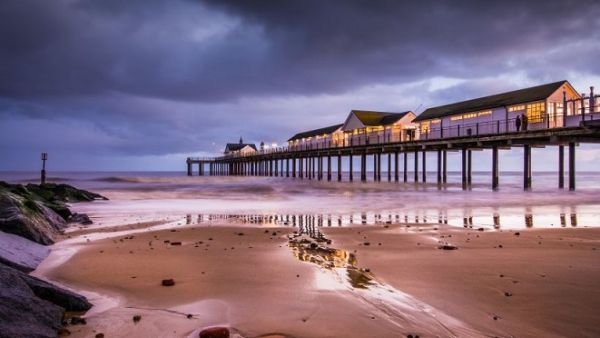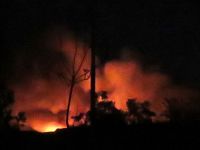Landscapes can be one of the easiest of all photographic subjects to shoot. Basically, all you need to do is find a nice view in the right lighting and snap away. Look a little closer at landscape images that really hold your attention, however, and you’ll often find that there’s much more to this simple subject than meets the eye.
To improve your landscape shots, you need to find visually compelling locations, and then you need to work out the right time of day and the right season to visit them, so they’re looking their absolute best.
Once all of this research and planning is done, you need the technical and artistic skills to make the most of the scene. All of this comes with practice – but where do you start, and how can you give yourself the best chance of landing some great shots? That’s where this guide comes in.
Rather than simply tell you to set your camera to an aperture of f/16, fit a wide-angle lens and use the rule of thirds, we’ll reveal the ten ‘laws’ that will help you plan more effectively, compose your shots, and understand when a trick or two might help. You’ll improve your success rate by going to the right places at the right times, and you’ll know how to get amazing images at any location.
- Qatar Petroleum Raises Foreign Ownership in Its Subsidiaries to 49 Percent
- Work Begins on $1.5 Billion Tourism Project in Aqaba: Jordan
So, don’t let your landscape photography get stuck in a rut: read each of these laws and take your landscape photography to the next level.
Law 1: Don't leave locations to chance
Learn everything you can about your landscape location before you go there – from likely viewpoints to where to park

You’re unlikely to stumble across great landscape locations by just going out into the country. It may seem like a lot of work to do, but it’s easy to check out the location, sun position, weather and tides before you set off.
The first port of call for most locations is an online map service, such as Google Maps. The amount of detail available on the satellite view, along with the Street View facility, is invaluable for getting an insight into the basic features and landscape.
Check out online photos of the location. We’re not suggesting you copy the approaches and styles employed by other landscape photographers: the images we use are more likely to be shots taken by tourists, say, who simply want to record the sights. These shots are perfect for getting a good idea of what to expect from a location, without the risk of subconsciously imitating what other photographers have done.
It’s worth doing this process even for areas you think you know well. It’s amazing how many hidden gems we’ve found just by using online maps and images.
Dig deep
Once you’ve narrowed down the area that you’re interested in, look at detailed maps like the Ordnance Survey series. These give precise details of paths and access, although you should check an online map as well to see if there are any other options. Look for likely car parking spots.
Next, check when and where the sun will rise and set. There’s little point going to a location if the main subject is in shadow because the sun’s behind a mountain. There are plenty of online resources, plus apps such as the Photographer's Ephemeris.
Law 2: Don't stick to your plan, regardless
Caught out by an unexpected shower? Make sure you have the flexibility to get the most out of your day
Even though you should always go out with a researched plan of what you want to shoot, it’s never set in stone. Mother Nature has a habit of regularly throwing plenty of curve-balls at you when you’re out on location. Expect the unexpected.
From surprise rain showers to strong wind and even pea-souper fog, it’s usually the weather that will scupper the best-laid plans. Along with the weather, you might also encounter unexpected alterations to a landscape, such as changes in the trees or flora, changes in water levels and even more dramatic events like landslides, which can all alter the scene dramatically, or simply prevent you from getting to your chosen location on time.
Time for Plan B
This is where it pays to have a back-up plan – and also to give yourself plenty of time to arrive at your shoot if you’re planning on working around sunrise or sunset. We usually try to get to a location at least 30 minutes before we think we might want to start shooting – even if it’s a place that we’ve visited before and know well – to give ourselves the time to explore the surroundings and come up with an alternative if things go wrong.
The bottom line is that no plan is perfect, however good your research is – but quite often we’ve found that having to think on our feet produces some fresh ideas that work even better than the original concept.
Law 3: Don’t always use wide-angle lenses
Be aware of the possibilities zoom or telephoto lenses can give you, and you’ll end the day with more creative images
Many landscape photographers shoot 80 per cent of their landscapes with a wide-angle lens, but it’s still worth taking along a longer lens for capturing those distant details that are impossible to shoot with anything else. For that other 20 per cent of images, around half are shot using the longer focal length setting of a standard zoom, the other half with a telephoto lens.
Stitched up
The other occasion where a longer focal length lens comes in is if you’re shooting a panorama. A wide-angle lens often distorts at least part of the image, making a sequence harder to stitch together. Using a telephoto lens keeps the perspective of the final result looking more natural.
Law 4: Don't use an ND grad for every shot
Sometimes filters can cause problems rather than fix them, so get to know the tricks that can help you out

Normally, we would advise getting the shot right in-camera: it saves time and effort adjusting and manipulating images later on. We’d much rather use an ND grad filter to capture detail in both the sky and the landscape of a sunset or sunrise shot than use fancy software techniques. But there are situations where it’s better to leave the ND grad filter in your bag and use other photographic techniques to balance the exposure.
The classic case is when there are mountains, buildings or trees above the horizon in your shot, and the sun is low in the sky. In these conditions, it’s impossible to keep detail in both the brightest and the darkest areas of the scene in a single exposure. But if you use an ND grad filter, any part of the scene above the horizon is darkened, making its use obvious.
HDR-Free
High-dynamic-range (HDR) processing is an option, but many people find that HDR rarely produces a natural-looking result, so we don’t tend to use it for landscapes. The latest digital SLRs, and improved raw-processing software such as Lightroom 6, mean that you can often reclaim a lot of the highlight and shadow detail.
Law 5: Don't just shoot in the best weather
Become a storm-chaser and you’ll get much more dramatic shots – but make sure you stay safe

Even though we can see the attraction of shooting landscapes while the sun is shining, we’re much more likely to get excited about the prospect of a good storm or weather front coming in than hold out for clear blue skies. This isn’t because we like getting cold, wet and blown around by gales, but because the colors, textures and light you can get just before or after a storm are among the most dramatic and eye-catching conditions for landscape photography.
Be careful out there
Going out in a storm isn’t to be taken lightly, because there are plenty of potentially dangerous things that can happen to both you and your kit. So, you need to make sure that you’re not putting yourself at risk, and that you have suitable clothing if the rain or wind takes a turn for the worse.
Protect your gear
Of course, you also need to make sure that your camera gear is safe and remains dry. Take a strong, waterproof plastic bag (a bin-bag is perfect), so that you can quickly cover the whole camera if it starts to rain while the camera’s fixed to a tripod. Carry plenty of cleaning cloths for the lens glass and filters, along with a microfibre towel for drying off the camera body and lens.
Law 6: Don't just shoot from one viewpoint
Explore your location thoroughly and you might find the viewpoint everyone else wishes they’d shot from

After you’ve done your research and looked at previous images of the location, it’s tempting to turn up and simply head straight for the viewpoint that has been shot many times before, or perhaps scout around but settle for the first viewpoint that you find that works. But there are usually many viewpoints that you can use, taking shots that offer a fresh take on a familiar subject.

Finding the right spot may be simply a matter of spending a few minutes walking around the location, trying to assess all of the possible viewpoints, and using different elements in the foreground or background. It may also be a more time-consuming process where you have to travel around a broader area and assess several different spots.
This second approach is more common if you’re shooting a large feature such as a mountain or a lake, where the possible viewpoints are some distance apart. Remember that this extra time and distance may also mean that you may get to all areas in a single visit, particularly if you want to capture sunrise or a sunset.
Law 7: Don't rely on the rule of thirds
Steer clear of rigid guidelines and learn how the landscape and your creative choices can complement each other

The classic rules of image composition are staples of all photography genres. The rule of thirds (which suggests dividing your frame into a 3 x 3 grid, then placing your focal point where grid lines meet) is perhaps the one most commonly applied to landscape photography. But in the real world, guidelines like this are more like handy suggestions than hard and fast rules – and if you rigidly stick to one composition, your shots can end up looking similar and slightly boring.
The other big problem with rules is that nature doesn’t always follow them. The landscape in front of you may not want to fit into a nice, regular rule-of-thirds composition. The key is to allow the subject to influence the composition, rather than trying to force the subject to conform to the rule.
Law 8: Don't include too much in the shot
Remember that less is more, and you’ll draw attention towards what matters most in your shot

Creating a strong, striking landscape composition is often as much about what you leave out of the frame as what you include. When you’re faced with a stunning landscape, it’s often difficult to decide what to exclude, so use a simple procedure to help out.
First, decide which part of the scene is essential to the composition. This is often the feature or subject that first made you stop and consider taking a shot, such as a mountain peak, a tree or even the colours in the foreground.
“Creating a striking composition is often as much about what you leave out of the frame as what you include”
Using this main subject, start to include other elements, usually one at a time, to see if they will fit into the composition without detracting from the main subject. With practice, you can do this without taking any photos, but one of the benefits of digital cameras is that you can try out different compositions, then scroll through the images on your camera’s rear display to decidewhich ones work.
Keep checking that all of the elements of the scene work together, and that the main element you identified at the start is still what your eye is drawn to.
Law 9: Don't think only in color
Learn the landscape situations that lend themselves to monochrome, and add a new twist to a favourite spot

There are two distinct weather and lighting conditions that prompt us to think in black and white. The first is a heavy, cloudy sky, which tends to produce very monochromatic results anyway. The second is when there are fluffy clouds in a bright, blue sky.
See from both sides
These two conditions produce very different results, and also need different approaches to produce the final image. The easier is when there’s blue sky, cloud and a landscape bathed in light.
Here, all you need to do is make sure that you’ve captured the full range of tones, and the black-and-white conversion is easy. We use a preset red filter conversion, available in Lightroom or Photoshop, to darken the blues and increase the contrast.
When shooting in heavy cloud, things are trickier. We often use an ND grad filter to darken the sky. After converting the image to black and white, you have to do a lot of dodging and burning to lighten and darken specific areas.
Law 10: Don't be afraid to revisit locations
To get the ultimate landscape shot, keep going back and use the knowledge you’ve earned from your previous visits

We’re always looking for new places to find insight and inspiration, but landscape photography is about more than simply ticking boxes off a checklist of locations. The way that light, seasons and weather change a scene is one of the most fundamental aspects of landscape photography.
It’s almost impossible to capture many of these amazing sights if you only visit a location once, then move on to the next one on your list.
We often return to locations – both close to home and in areas that we visit regularly – to learn more about how the lighting and weather combine to lend a different look to the landscape.
Save time
Returning to a location means you can spend less time researching the area, although it’s still good to look out for viewpoints, compositions and subjects you might have missed.
By








